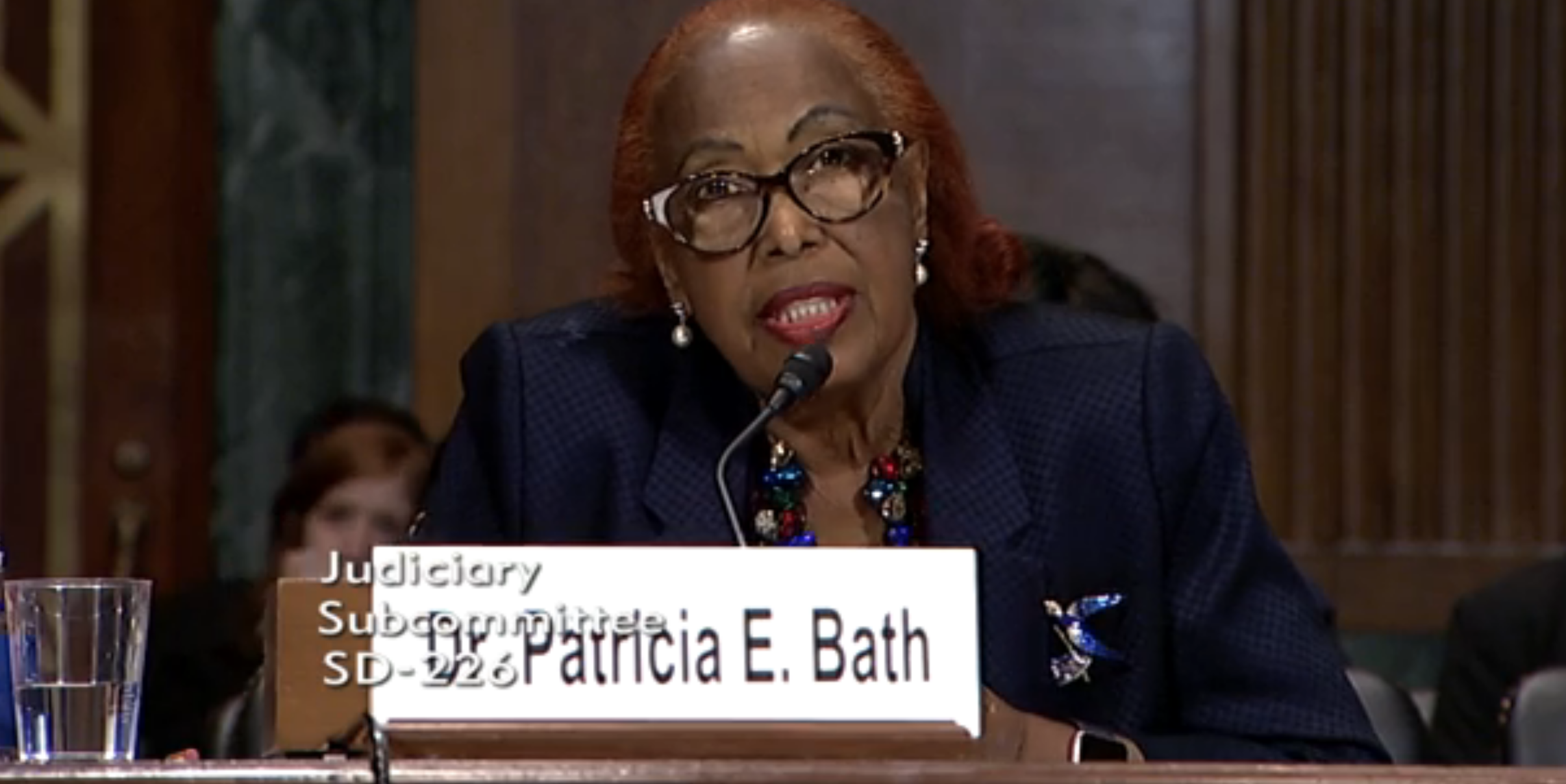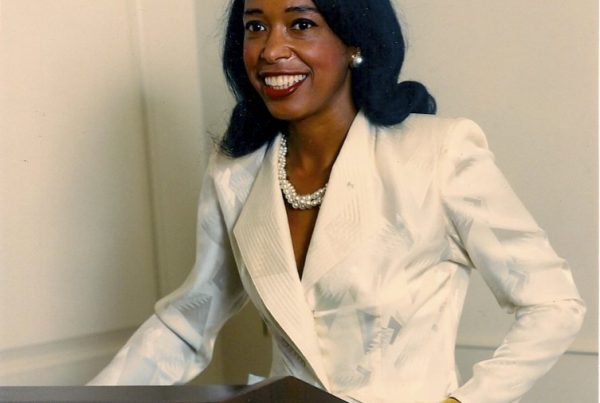Subcommittee Hearing on Intellectual Property – Testimony of Dr. Patricia E. Bath, April 3, 2019, before the Judiciary Committee on Trailblazers and Lost Einsteins: Women Inventors and the Future of American Innovation.
For the video on the Subcommittee Hearing, the Committee on the Judiciary.
Following is the transcript of Dr. Patricia Bath’s testimony at the subcommittee hearing.
Chairman Graham, Ranking Member Feinstein and Members of the Committee:
I thank you for the invitation and opportunity to speak before the committee. Of the many titles associated with my name and work I choose to speak to you from the viewpoint, lens and focus of a woman inventor. It is my hope that my sharing my views, experiences and recommendations that other women inventors will keep the faith, not give up and pursue their intellectual property goals with renewed vigor.
This afternoon I will divide my remarks into 3 parts.
In Part One I will cite clear and definitive evidence of gender disparities in IP resulting in fewer women inventors. In Part Two of my testimony I will share my personal story as a woman inventor who recognizes that her own personal struggles recapitulate the systemic struggles of women inventors and scientists throughout history. Finally, in Part Three, I hope to provide some recommendations and thoughts to remedy the problem.
PART ONE
The 2019 study by the USPTO determined that women inventors were at an annual rate of only 12%.(1) In 2017 the Opportunity Insights team at Harvard reported that “women are among the “lost Einstein’s” — people who would contribute valuable inventions had they had early exposure to innovation and inventor role models.(2) In the same study the Harvard Team, led by Alex Bell stated “if women, minorities, and low-income children were to invent patented technology at the same rate as white men from high-income (top 20%) households, the rate of innovation in America would quadruple ” Well we know that science and engineering fields have historically been known to generate the most patentable inventions. (3) Unfortunately, women comprise only 28% in these two fields.
I think this is a good Segway into Part 2 and my own trials, tribulations and triumphs as a woman inventor
PART TWO
When the Harvard team led by Alex Bell compared “nature (innate inventive ability)” by “nurture (environment) they found that “children from high-income (top 1%) families are ten times as likely to become inventors as those from below-median income families.” But, sometimes there are exceptions to the rule because as a minority woman inventor from a low income environment and I succeeded against the odds.
I was born in Harlem New York to Gladys and Rupert Bath. My father immigrated from Trinidad and my mother migrated from North Carolina and both came to New York city in pursuit of the American Dream.
My father was a MacGyver type Dad with extraordinary mathematical skills and my Mom loved sewing and art. So, I and my brother Rupert got a STEAM head start with at least the M and the A of STEAM.
I would be remiss in my testimony if I only talked about my invention and my struggles without recognition of the pioneering women scientists and inventors before me. I will only mention a few given the time constraints.
I first wish to pay homage to NASA scientist Katherine Johnson and juxtapose one of my experiences with hers. I call it my Katherine Johnson Moment. In the movie Hidden Figures, we learned that frequently her name was deleted or restricted from appearing on scientific publications of her work. Her IP misappropriation happened in the 1960’s and my
Katherine Johnson moments happened in 1988 when my work was included in a Williams and Wilkins textbook publication on Intraocular Lenses and my contribution was not properly credited in the same manner as other authors.(4)
Similarly, in a 1989 textbook publication on Ophthalmic Surgery by MOSBY, my contribution was not properly credited in the same manner as other authors.(5) I call this my Katherine Johnson Moment because my own experience in 1988/1989 mirrored hers. Accordingly, based on my own personal experience the oversight, slights and disrespect of scientific contributions of women scientists and inventors demonstrated in the 1960’s continues even today.
Next, I must acknowledge the pioneering contributions of women scientists Rosalind Franklin, Ester Lederberg, Lise Meitner, Chien-Shiung Wu, and Nettie Stevens. Nettie Stevens did the original work that discovered sex determination was due to the male species contributing the Y chromosome in 1861. However. years later her colleague Thomas Hunt Morgan published similar findings in 1900 without citing the work of Nettie Stevens and not only claimed credit but is currently recognized as the person who “discovered chromosomal sex determination”. Based on a combination of the Matilda (6) effect, lack of scholarliness and/or gender bias Thomas Morgan is credited for a discovery made by Nettie Stevens.
I now wish to pay homage to scientist Nettie Stevens and juxtapose of my experiences with hers. I call it, “my Nettie Stevens moment”. In 1978, I discovered African Americans has double the prevalence of blindness compared to White Americans and published my findings in a peer review medical journal (7). Several year later, in 1990, researchers at Hopkins published a study (8) that included the same findings, namely that African Americans had double the prevalence of blindness compared to White Americans. They failed to cite my earlier work. Was this plagiarism, oversight or bias? Although my original findings were republished (9) there was never a correction of the record. Based on a combination of the Matilda effect, lack of scholarliness and/or gender (and perhaps racial) bias Alfred Sommers and Hopkins are credited for my discovery in lieu of myself to this day.
Part 3
The Judiciary subcommittee is at initial stage of investigating the factors associated with the “Lost Einsteins”. In order to correct the disparities, programs need to be launched in early childhood education. We need to support STEM/STEAM throughout the educational infrastructure of the USA beginning in K1. The pipeline for increasing women scientists and engineers begins by igniting the spark for learning and curiosity beginning in K1.
The creative spark must be nurtured in an environment enriched with resources and assets to amplify learning. Accordingly, I submit to the Committee that the correction course for having more women in science and engineering and more women earning patents must begin with K1-K6 As evidence of my passion for this remedy I brought my daughter Dr. Eraka Bath and granddaughter Noa Fortuit to bear witness to my testimony which is a part of my legacy. I recently authored a children’s book entitled, Rainbow Science: What, Why and How? which advocates STEM and diversity.(10)
For at least two decades I have been recognized for my invention related to laser cataract surgery known as Laserphaco.(11, 12) The costs of filing for a patent can be prohibitive especially when the goal is to obtain worldwide rights. There are some resources of the USPTO that may not be well known to the individual inventor. The USPTO provides an assistance center for individual inventors that I have used and found helpful.
At various stages of the prosecution of my application I had to act as my own attorney and found the IAC an excellent resource. One of the most important changes in USPTO patent law occurred in 2013 when the USPTO adopted the “first to file” as the determinant for invention ownership rather than “first to invent”. I and most small inventors celebrated this rule change as a win for small entrepreneurship.
Corporate sponsorship is especially necessary if you have an invention which will require clinical trials. However, corporations have an inherent bias because of the issue of “brand” recognition. If you don’t look like you can represent their brand (based on their media authorities and biases) the veracity and power of your IP may not win a sponsorship. Until there is a true and vibrant corporate culture of equity, diversity and inclusion women and minority inventors will remain diminished and disadvantaged.
Bias and lack of diversity and inclusion at the corporate and university levels needs to be corrected by leadership at the executive levels. The token corporate committees on Diversity, Equity and Inclusion are ineffective without leadership at the Executive and CEO level. More women and more minority women need to be on the Boards of Corporations. I am a proud citizen of the great state of California where legislation has already been enacted to include women on corporate boards. I would add the caveat of minority women.
Finally, the greatest weapon in our toolkit is scientific integrity. When all else fails, truth and scientific integrity will triumph. In the presence of family, legacy and women inventors, past, present and future, I pledge my inalienable championship for scientific integrity and truth.

